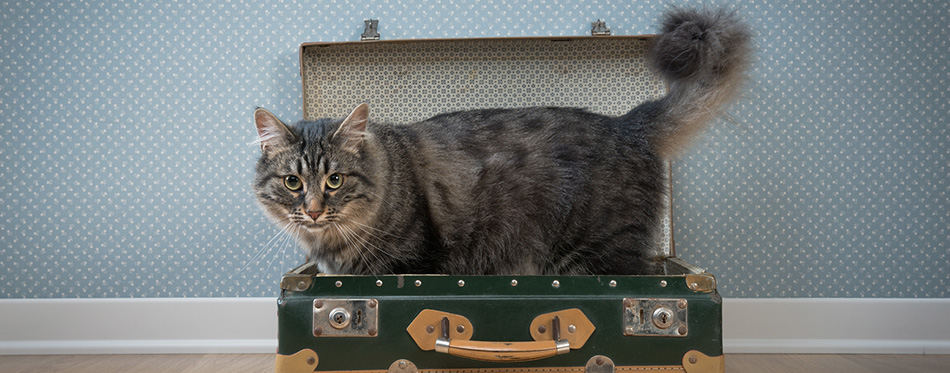PetSide may earn a small commission from affiliate links in this article.
Learn more
While you might be excited about moving to a new place, some members of the family can feel differently. A move is stressful especially for the four-legged residents, like your beloved cat. Relocating a cat is tough because they tend to be very territorial, preferring a familiar place and being resistant to anything new in their routines. While it might not be the easiest time for your kitty, there are ways to make it work out.
The most important thing when it comes to moving with a cat is to minimize the stress as much as possible. Thus, the transition into new surroundings occurs much easier and there is a lower probability for your cat to act afraid or anxious.

Tips For Moving With Your Feline Pet
- Keep The Normal Routine
One of the secrets on how to move with a cat is to keep everything as normal as possible, even while you are slowly packing your possessions. But to reduce anxiety and fear in your pet, you should do your best to keep a consistent and predictable routine. This includes keeping the usual schedule of playing, feeding, and cuddling. You might even consider showering your kitty with a bit more hugs and treats. - Use Pheromone Therapy
Using pheromones can keep your cat calm and at the same time address the question of how to acclimate a cat to a new home. From the time you start packing, during the move, and all the way up to settling in the new place, these pheromones can keep your pet less anxious about the relocation. You can also choose between various ways to deliver these pheromones, from sprays to wipes, and diffusers. There are even pheromone-based calming collars out there. Find out more about cat calming sprays here. - Keep Them Safe In One Room On The Day Of The Move
The hustle and bustle of the movers can make your kitty confused and scared. On the day of the move itself, you might want to keep your pet safe and peaceful in one room. Bring in its bed, water, litter box, and cat toys to make this spot in the old house comfortable while the moving company is doing its job. For more options, check out our detailed reviews of the best cat litter boxes and best cat beds. - Consider Getting A Mild Sedative
One of the most important tips for moving a cat to a new home is to plan for the drive. If your new place is a few streets away, then there is no need to worry about transport. However, if you need to stay longer in the car and your kitty is not a huge fan of cars, then you might want to talk to your vet about getting some mild sedatives.
This is the ideal solution especially if your new place is a bit of a drive away. Leaving the familiar and getting to know a new house can already be very distressing, so you might not want to add to the stress by driving far. - Introduce The New Home Slowly
One of the ways how to introduce a cat to a new home is to do it step by step. This makes it possible for you to introduce everything slowly and for your kitty to slowly warm up to the new environment. Of course, getting settled in can vary between animals and people, but if you have an adventurous feline, then you can let it explore the new rooms as much as it wants. Timid pets, on the other hand, need to go slow, so introduce one room of the new place at a time. - Assign An “Introduction Room”
Much like you keep your pet in one part of the house on moving day, you can identify an introduction room. It needs to be a spot that is quiet and away from the hustle and bustle. Make sure the food and water bowls, litter box, and bed are ready by the time the kitty is let out of the carrier.
The rest of the house can be introduced through some low-key activities like watching TV or reading. If the pet is reacting positively to the new space, you can reward it with some treats. Sprinkling some cat treats around the house can also reinforce good behavior and increase feelings of comfort and security.

- Decorate With Cat-Friendly Designs
Your kitty will most likely warm up to the new place if it is cat-friendly. This means, offer corners for exploration, windows with a blanket to lie on, and its usual cat toys and tower. When the furniture is familiar, your pet will have less anxiety. Head over to our review of cat window perches for more choices. - Spread Your Cat’s Smell
Pets, especially cats, love to smell around and search for scents in the environment from other animals. One way to help your kitty feel at home in the new place is to spread its smell around. All you need is a clean sock or cloth, rubbing the cloth around the mouth to get its pheromones. Then scrub the cloth around the new place (all over the rooms at cat’s height) until your kitty explores independently and without fear. - Watch For The Cat’s Cues
You do not want to rush your cat to love the new place, especially when it is bigger. The move and the changes can already be too much for your pet, and any pressure from you to like it can have a negative effect on your kitty.
Unfortunately for every family member, two- or four-legged, a move can be necessary. While the new place might have its charms compared to the old, like more space to run around, the relocation itself can be met with a bit of resistance.
Overcome this by adopting the right steps to say goodbye to the old place and get used to the new house. The tips above are just some of the ways to do so! Most times, pets just need a bit of time to get used to the changes. Keeping the usual routine is also a good way to maintain a sense of normalcy at home. Before you know it, your kitty has found a new place to explore, conquer, and lord over.
Source:
- Moving Home With Your Cat – Cats Protection

